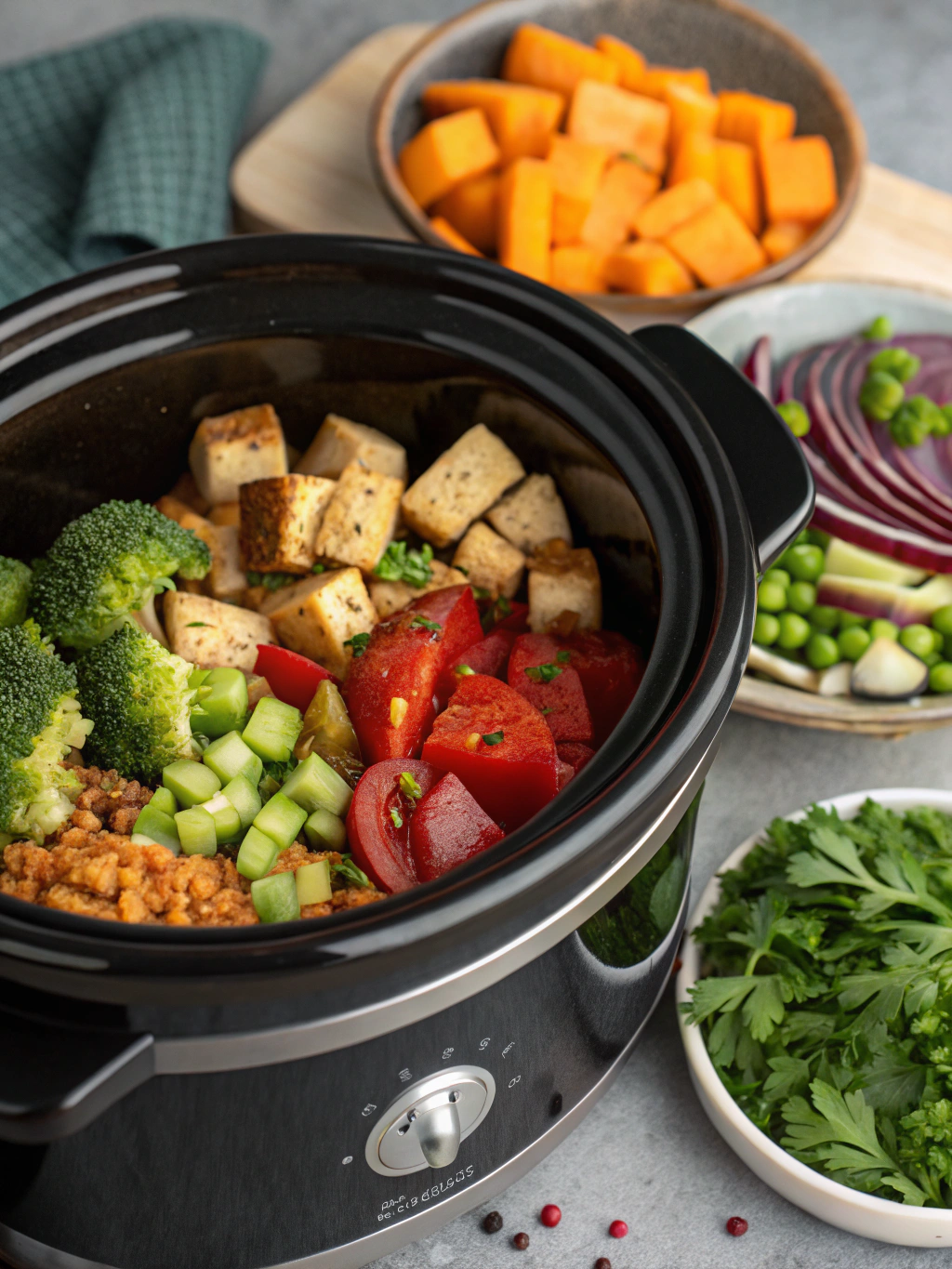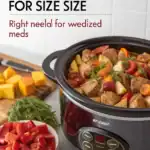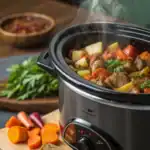Table of Contents
How to Master Vegetarian Crockpot Basics for Newbies: 7 Tips
Are you overwhelmed by the thought of meal prep? Or perhaps you’ve heard that cooking vegetarian meals can be complicated and time-consuming? Well, you’re not alone! However, what if I told you that adopting a vegetarian diet could be as simple as setting your slow cooker and walking away? In this post, we’ll dive into Vegetarian Crockpot Basics for Newbies with 7 essential tips to get you started on your journey toward easy, delicious, and nutritious meals.
Ingredients List

When it comes to vegetarian crockpot meals, simplicity is key! Here are some essential ingredients you’ll need, along with alternatives:
- Vegetables: Carrots, potatoes, bell peppers, onions, or zucchini (for a twist, try sweet potatoes or parsnips)
- Legumes: Canned beans (black, kidney, or garbanzo) or lentils (dried or canned)
- Grains: Rice, quinoa, or barley (opt for brown or whole grain for added nutrition)
- Broth: Vegetable broth for a rich base; consider low-sodium options
- Herbs & Spices: Basil, oregano, cumin, and garlic (fresh or dried)
- Sauces: Tomato sauce, soy sauce, or coconut milk (for creaminess)
- Protein: Tofu, tempeh, or seitan (for those who need added protein)
These ingredients not only make cooking easier but also offer endless combinations to delight your taste buds.
Timing
Knowing your timing is crucial in the world of slow cooking. Most vegetarian crockpot recipes take about 4-6 hours on high or 6-8 hours on low. This means you can throw everything in before heading to work and come home to a delightful aroma. To put things in perspective, this is about 30% less time spent actively cooking compared to traditional stovetop methods.
Step-by-Step Instructions
1. Prepare Your Ingredients
Start by chopping your vegetables into bite-sized pieces and mis en place your herbs, spices, and any other components. This makes it easy to just dump into the cooker.
2. Layer Wisely
Place heartier vegetables like potatoes and carrots at the bottom of the crockpot, as they take longer to cook. Add legumes and grains next, and then finish with softer vegetables and herbs on top.
3. Add Liquid
Ensure you have enough liquid in your recipe. A general rule is to add at least 1 cup of broth or liquid. The moisture is key in preventing burning and helping everything cook evenly.
4. Set the Timer
Choose your cooking time based on your day. If you’re heading out, set it to cook on low for 8 hours. If you’re home and want a quicker meal, opt for high for 4-6 hours.
5. Stir (if you can)
If possible, stir the mixture midway through cooking to ensure even heat distribution. This is optional, but it can enhance flavors.
6. Check for Doneness
Once the cooking time is up, check that all components are tender. If needed, you can cook for an additional time in 30-minute increments until everything’s just right.
7. Serve & Enjoy!
Once everything is perfectly cooked, serve your delightful dish warm, garnished with fresh herbs or a squeeze of lemon for an extra flavor pop.
Nutritional Information
A typical serving of a vegetarian crockpot meal combines a rich mix of dietary benefits. Here are some insights:
- Calories: Approximately 250-350, depending on your ingredients
- Protein: 12-20 grams (primarily from legumes and grains)
- Fiber: 8-12 grams (excellent for digestion)
- Vitamins: A rich source of Vitamins A, C, and various B vitamins
Vegetarian meals can be lower in saturated fat and cholesterol while being high in essential nutrients.
Healthier Alternatives for the Recipe
You can easily enhance nutritional benefits without sacrificing flavor. Here are some swaps:
- Whole grains: Use quinoa instead of white rice for added protein and fiber.
- Lower sodium options: Choose low-sodium broth and canned beans to better manage sodium intake.
- Sneak in greens: Add spinach or kale toward the last 30 minutes of cooking for an extra boost of nutrients.
Serving Suggestions
Serve your delicious crockpot meal over a bed of greens for a fresh crunch or add a dollop of yogurt or sour cream substitute for creaminess. You can also pair it with whole-grain bread or pita for a filling complete meal.
Common Mistakes to Avoid
Even the best beginners can fall into pitfalls. Here are common mistakes and how to avoid them:
- Not enough liquid: Ensure your recipe has enough broth; otherwise, you risk burning the food.
- Layering issues: Remember to place hearty veggies on the bottom to avoid undercooked ingredients.
- Overcrowding: Avoid overfilling your crockpot as it can lead to uneven cooking.
Storing Tips for the Recipe
Leftovers can be a boon when it comes to meal prep. Here are some practical tips for storing:
- Cool before storing: Allow your meal to cool completely before placing it in the refrigerator to maintain texture and flavor.
- Use airtight containers: This helps in preserving freshness and avoiding contamination.
- Freeze extras: Most vegetarian crockpot meals freeze well for up to three months. Just thaw overnight in the refrigerator before reheating.
Conclusion
Cooking vegetarian meals doesn’t have to be complicated or time-intensive. With these tips, you’ll master the art of using your crockpot effortlessly, creating delicious, healthy meals that make life easier! So why wait? Jump in, try out the Vegetarian Crockpot Basics for Newbies, and rediscover the joy of simple cooking. We’d love to hear how your first attempt goes, so be sure to share your feedback and any variations you tried!
FAQs
1. Can I use frozen vegetables in the crockpot?
Yes, frozen vegetables are fine to use. Just remember they may release extra moisture, which can slightly alter cooking times.
2. How do I know when my crockpot meal is done?
The best way to check is to test the tenderness of vegetables and grains. Everything should be fully cooked and tender.
3. Can I cook without oil?
Absolutely! Many vegetarian meals cook beautifully without oil, as long as there’s enough liquid to keep things moist.
4. Is cooking in a crockpot more energy-efficient?
Yes, cooking in a crockpot generally uses less energy compared to an oven or stovetop, making it a greener choice for meal preparation.
Dive into the wonderful world of vegetarian cooking and simplify your meal prep today!



